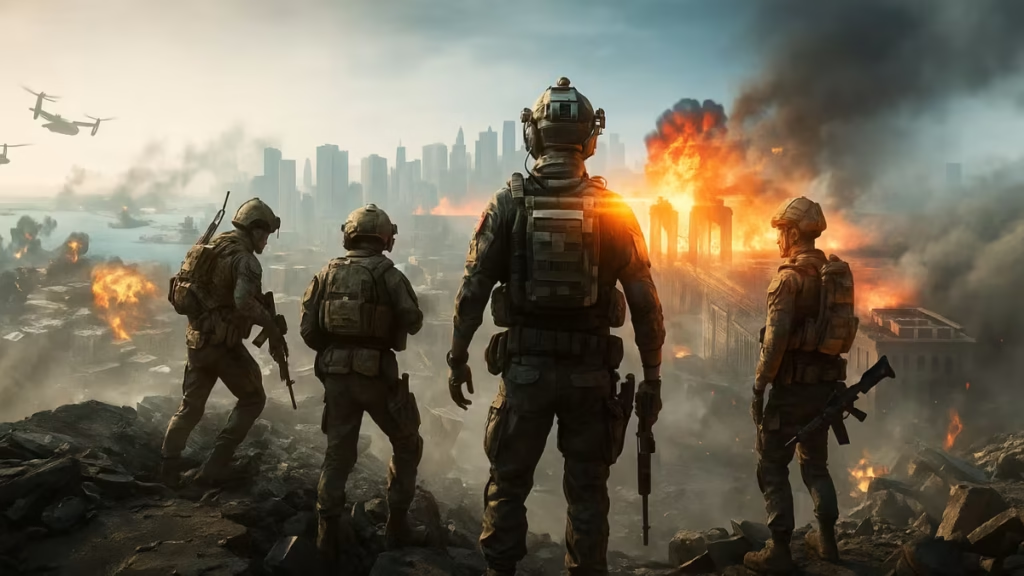After the divisive reception of Battlefield 2042, fans were eager to see if Battlefield 6 could restore the franchise’s identity. The good news: it mostly succeeds. By grounding itself in traditional large-scale warfare while adding some modern refinements, Battlefield 6 delivers a thrilling—if cautious—return to form.

From the first match, it’s clear that Battlefield 6 aims to recapture what made the series iconic: sprawling environments, destructible terrain, and multi-layered warfare. The game’s combat unfolds across three distinct layers — infantry skirmishes, vehicular clashes, and intense dogfights — each interlocking seamlessly to create the sense of all-out war the franchise is known for.
Gunplay feels tight and satisfying, with just enough recoil and bullet drop to reward precision without alienating newcomers. Each weapon crackles with power, enhanced by excellent sound design — the echo of distant explosions and whine of jets overhead add an unmatched sense of immersion.
Classes and Combat Roles
The traditional four-class system returns, and it’s one of the game’s smartest moves. Assaults thrive in direct combat, Engineers specialize in vehicle warfare, Medics keep squads alive under fire, and Recons provide long-range support. Each role feels distinct and meaningful, encouraging teamwork without forcing rigid playstyles.
The new Kinesthetic Combat System adds smoother movement, letting players mantle, crouch-sprint, and drag wounded allies to cover. While it occasionally borders on arcade-like (especially with knee-slides), it largely enhances the sense of fluidity in both close-quarters and large-scale engagements.
Destruction, Vehicles, and Scale
Destruction has always been Battlefield’s calling card, and here it’s better than ever. Buildings crumble realistically, cover vanishes under tank fire, and each explosion reshapes the battlefield. Whether you’re shelling enemy positions from a tank or piloting a jet across the smoldering skyline of Mirak Valley, Battlefield 6 nails the cinematic chaos that few shooters can match.
Vehicles feel weighty and powerful, but mastery takes skill — good tank commanders and pilots can turn the tide of battle, though newcomers may find the steep learning curve daunting. Unfortunately, there’s still no dedicated flight training mode, making aerial combat intimidating for first-time pilots.
Map Design and Modes
The nine launch maps are varied, ranging from the dense urban combat of Saints Quarter to the sweeping battlefields of Mirak Valley and Liberation Peak. Each one has been designed with verticality and destructibility in mind, rewarding players who learn the terrain.
Classic modes like Conquest and Rush remain the highlights, emphasizing teamwork and vehicle integration. Newer additions like Escalation and King of the Hill offer shorter, more focused experiences but lack the grandeur that defines Battlefield’s best moments.
Infantry-only modes such as Team Deathmatch feel unnecessary, stripping away much of what makes Battlefield unique. This series has always thrived on chaos, not corridors.
Single-Player Campaign: A Safe, Shallow Ride
The campaign, unfortunately, doesn’t match the ambition of multiplayer. You play as members of Dagger 13, an elite Marine squad fighting against the private military corporation Pax Armata amid a collapsing NATO alliance. While the premise is promising, the execution feels routine and derivative.
The nine missions offer little innovation — expect the standard mix of stealth sections, turret sequences, and corridor firefights. Occasional open-area missions hint at potential, but limited freedom and repetitive objectives hold them back.
Character writing fares no better. Dagger 13’s soldiers are one-dimensional, their dialogue filled with clichéd military bravado. Without emotional investment or memorable moments, the story feels like a checklist of FPS tropes rather than a gripping modern war tale.
Still, the campaign serves one practical purpose: a training ground for new players before diving into multiplayer. Beyond that, it’s forgettable.
Technical Performance and Optimization
Visually, Battlefield 6 is stunning. Lighting, particle effects, and environmental destruction push Frostbite to its limits. Explosions bloom across skylines, debris clouds fill the air, and every battlefield feels alive. Even better, performance remains remarkably stable, with few frame drops even during the most chaotic sequences.
Audio is equally exceptional. Battlefield’s sound design has long been its secret weapon, and this entry continues that legacy — from the distant rumble of collapsing towers to the heart-thumping crack of nearby gunfire, it’s pure immersion.
See also: How to Unlock Battlefield 6 Free Skins and Rewards Early in Battlefield 2042
Battlefield 6 doesn’t reinvent the wheel — and that’s precisely why it works. After years of experimentation, this is Battlefield rediscovering its roots: large-scale warfare, teamwork, and unpredictable chaos. Its campaign may falter, and some concessions to modern shooter trends (like open weapon choices) dilute its identity, but when it leans into what it does best, it’s outstanding.
With solid gunplay, excellent map design, and truly spectacular destruction, Battlefield 6 reaffirms that no other FPS delivers war quite like this.
Verdict
- Pros:
- Authentic large-scale warfare and destruction
- Excellent sound and visual design
- Well-balanced class system
- Satisfying gunplay and vehicle combat
- Cons:
- Weak, forgettable campaign
- Small-scale modes feel unnecessary
- Lack of flight training options
Final Score: ★★★★☆ (4/5)
Battlefield 6 is the best entry the series has seen in a decade — not because it’s revolutionary, but because it finally remembers what Battlefield should be. Play Now!

